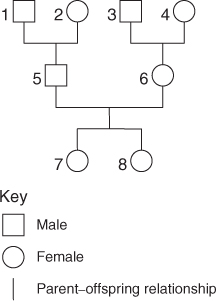10.10 A more general pattern in the covariance matrix: Analysis of pedigrees and genetic data
In all the mixed models we have considered so far, the covariance matrix for each term is of the form shown in Equation 10.27 – an identity matrix, having 1s along the leading diagonal and 0s elsewhere, multiplied by the variance component for the term in question. However, the covariance matrix need not be so simple: we have already seen an instance of non-zero covariance between two random-effect terms, namely the slopes and intercepts in the random-coefficient model (Sections 7.5–7.7; see also Exercise 10.3 at the end of this chapter). For an example of non-zero covariances within a single term, consider the pedigree in Figure 10.8, which represents three generations of animals. Earlier generations are represented in higher rows of the pedigree: animals represented in the bottom row are the most recent generation, those in the row above are their parents and those in the top row their grandparents.

Figure 10.8 A pedigree representing three generations of animals.
Suppose that a continuous variable Y (e.g. weight) is measured on each animal in this pedigree, and that this variable comprises a genetic effect Γ and an environmental effect Ε, so that
where
- μ = the mean value ...
Get Introduction to Mixed Modelling: Beyond Regression and Analysis of Variance, 2nd Edition now with the O’Reilly learning platform.
O’Reilly members experience books, live events, courses curated by job role, and more from O’Reilly and nearly 200 top publishers.

